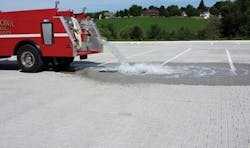About the author: Jon Biederman, P.E., LSI, is branch manager for Fehr Graham. Biederman can be reached at [email protected] or 563.422.5131.
The city of Monona, Iowa’s Family Aquatic Center was in desperate need of improvements to its existing parking lot. The lot, constructed in 2004 as part of the initial building project, was not the primary focus at the time of construction and was allotted a minimal budget. The parking lot was conformed to existing steep grades and built with crushed stone to minimize construction cost. Because striping was not an option on the aggregate surface, the parking area was unorganized, inefficient and typically only provided parking for around 25 vehicles at any given time. Even the entrance to the parking area was less than desirable as it was constructed in excess of the preferred maximum grade of 8%.
Increased runoff into nearby Silver Creek, a tributary of the Turkey River, was a result of storm water originating from the aquatic center parking lot. The gravel parking lot was without storm drainage infrastructure, thereby enabling erosion within the parking lot and the adjacent street. As a result, storm water, sediment and any pollutants traveled downhill directly into Silver Creek.
To solve runoff problems and in an attempt to further protect the Silver Creek watershed, the city of Monona partnered with several agencies, including the Iowa Department of Natural Resources, Clayton County Soil and Water Conservation District, Iowa Department of Agriculture and Land Stewardship, Northeast Iowa Resource Conservation and Development, and engineering and environmental firm Fehr Graham.
Funding Found
A potential funding source was identified for the parking lot through the State Revolving Fund (SRF) program, which the city of Monona was utilizing for a wastewater treatment plant upgrade. This unique funding opportunity utilized the interest to be paid on the SRF for the city of Monona as the means to fund the project, effectively getting two projects for the price of one. The requirement for the funding was a project that would result in the improvement of the quality of the effluent discharged to the watershed. It was determined that this funding source would be able to fund nearly all of the proposed parking lot improvements.
With $260,000 secured, the city reached out to Fehr Graham to develop a plan for a permanent solution to meet the water quality requirements and improve the usefulness of the parking lot. Calling on previous experience with permeable pavement, Fehr Graham presented the city with a design concept for the new parking lot.
Money Into Action
The design incorporated numerous storm water management features. The use of permeable pavers allowed for storm water treatment as well as runoff control by detaining water in the aggregate base under the paver section. In addition, the aggregate base course enabled infiltration of storm water, as opposed to the full release of all surface water from the parking lot to Silver Creek. Because the native soils are clay-based with low permeability, a reservoir was designed at the downstream end of the parking lot to increase the available storage necessary to accommodate the lower infiltration rates. This reservoir is nearly 7 ft deep and constructed of aggregate material. The reservoir is designed to store a 100-year rainfall event from the entire parking lot.
An underdrain system acts as a relief of the reservoir. An outlet structure and a 4-in.-diameter gate valve were added to the underdrain system to allow some control to the rate of release of excess flows from zero discharge to full pipe capacity.
In addition to the water quality improvements, the grade of the parking lot entrance was reduced, allowing for a safer traffic pattern. The redesign also provided for an improved layout of the parking stalls resulting in the ability to accommodate as many as 45 vehicles and meet current ADA requirements. Colored pavers enhance aesthetics and are used to delineate parking stripes and accessibility symbols, making them permanent and reducing future maintenance costs for repainting.
Results
To demonstrate the effectiveness of the new permeable pavers, the city of Monona’s fire department tested the new parking lot using a city fire truck to rapidly release 2,000 gal of water directly onto the pavers. The results were flawless, with no standing water or runoff. The water passed with ease through the spaces of each paver to the underlying stone base. The stone base acted as a filter to remove sediment before the runoff reached Silver Creek at a slow, controlled release rate from the parking lot.
The city of Monona made an initial investment through the SRF program to upgrade its wastewater treatment plant. The city took a proactive approach by utilizing the interest funds to update a new parking lot, which resulted in the elimination of runoff, improved water quality and aesthetics and reduced yearly maintenance. Of the roughly 30 other communities taking advantage of similar funding situations, Monona was the first to complete its project.
The project has received awards and special recognition. At the 2015 Iowa Water Conference in Monona, the city of Monona and Fehr Graham received an award recognizing their performance related to watershed protection and improvement of urban water quality. The award acknowledged the Monona Aquatic Center parking lot project and the role it played in protecting and improving urban watershed quality in Iowa. In addition, the project received a 2016 Honor Award from the American Council of Engineering Companies of Iowa for a special project related to engineering achievements.
Download: Here


